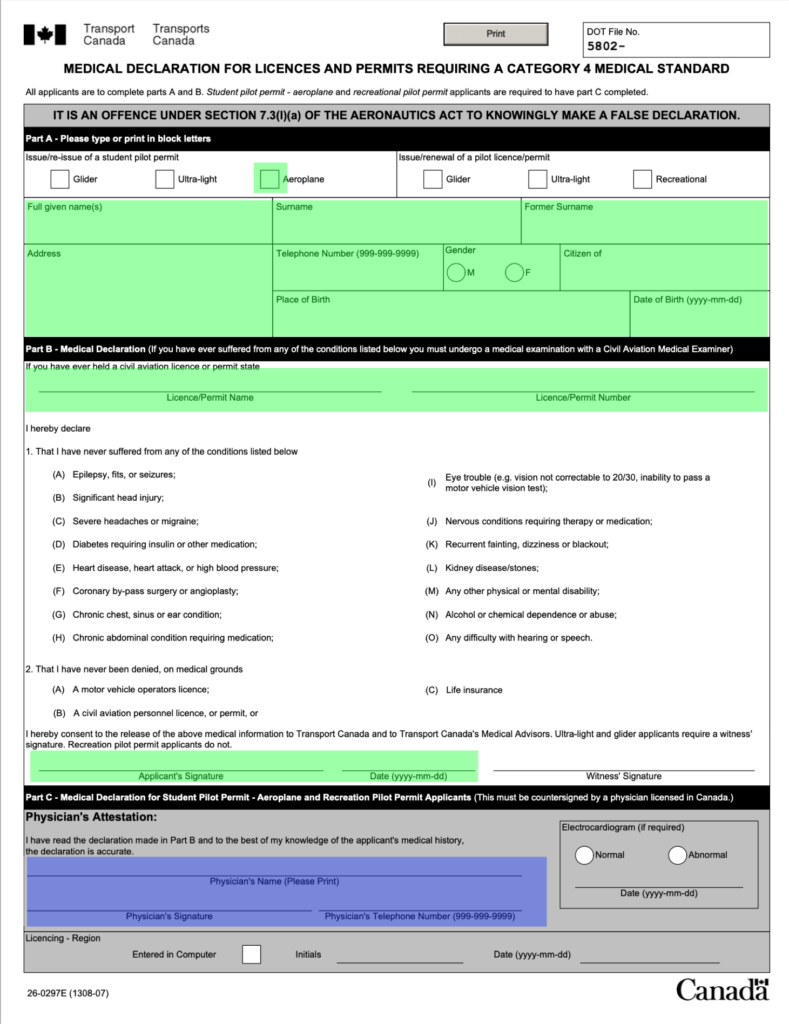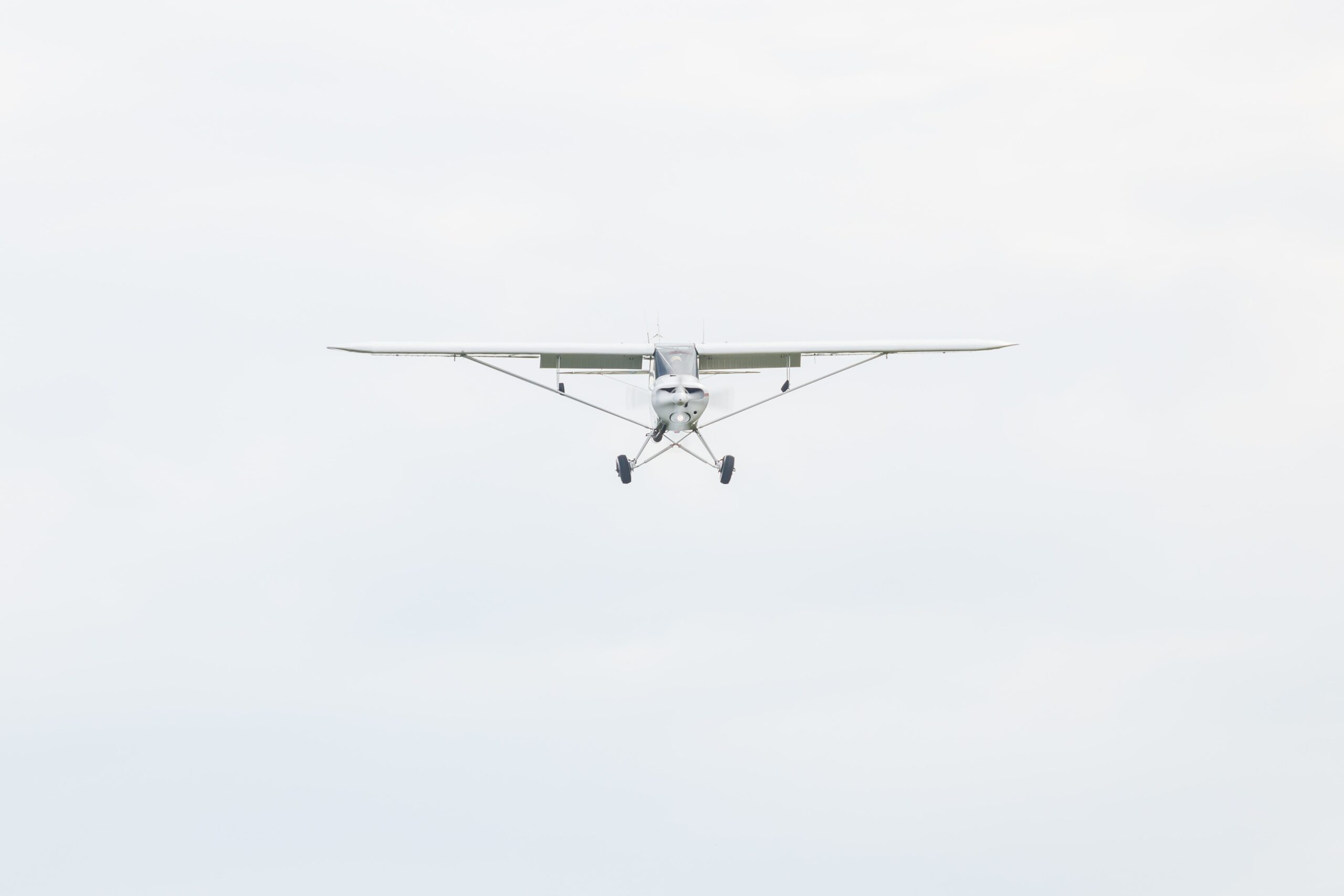On this page
Medical certificate
Headsets
Headsets
Other things to buy
Where to come for your first lesson
Medical certificate
To learn to fly and to get get a pilot licence you’ll need a medical certificate.
In the old days, pre-COVID, at the beginning of their training every student would go and visit a Civil Aviation Medical Examiner (CAME) and be prodded poked and quizzed for a Category 3 medical certificate, which is what you need for a PPL. The CAME would send their report to Transport Canada and about a month later the certificate would arrive, well in time for the student’s first solo flight, which is the first time they actually need their own medical certificate.
Sadly, because of COVID and other factors the delays with Transport Canada’s processing of Category 3 medicals are very long – sometimes many months. This is longer than it takes most students to reach a solo standard – but they can’t start to fly on their own without the medical certificate. So their training gets delayed.
Therefore at present, I recommend students initially apply for a category 4 medical certificate. A category 4 medical certificate will still permit you to fly solo, and it’s much quicker to arrive. You can apply for the category 3 medical certificate after the catgegory 4 medical certificate is issued.
To get a category 4 medical certificate fill out and print this form:
https://wwwapps.tc.gc.ca/wwwdocs/Forms/26-0297E_1308-07_E.pdf
Tick only one box near the top, the marked “student pilot permit” “aeroplane”. Don’t tick any other boxes in that row.
Sign and date part B in the space provided. You do not need a witness signature.
Take it to your family doctor and have them fill out the first section of part C (only).
When it’s completed, the only parts that you should have written on are the parts in green here. And the only parts your doctor should have written on are the parts in blue. There should be nothing written in any other part of the form.

This is very important: do not alter or add anything in part B. Neither you nor your doctor may make any annotations on or amendments to the declaration in part B. If you change anything, or add any extra words, comments, information, clarification or other what-not anywhere in section B, your application is guaranteed to be denied.
What if you or your doctor don’t feel part B applies to exactly you as-is? Then unfortunately you don’t qualify for a Category 4 medical, and you will have to apply for a Category 3 medical instead, which takes longer. Contact me for advice if that is the case.
ECG: Regardless of what anyone tells you, even if you are over 40 you do not need an ECG for a category 4 medical for a Student Pilot Permit. Do not delay your application or complicate it by submitting an ECG. Do not include any extra information like eyesight reports, letters from your doctor, or test results. If you do, your application will be rejected.
Some people reading this page will be returning to flight training after a long gap – maybe even 20 or 30 years. Those people will probably have held a medical certificate at that time period, even if they now have absolutely no records or documents relating to it. If that is you, then you should not complete this form and you should not send it to Transport Canada. Instead, I have very good news for you, but I’m not going to tell you what it is and what to do next until you email me directly.
For everyone else, once you have the form completed. email it to me, or directly to aviation.ont@tc.gc.ca. If you send it to me I can check for mistakes; if you send it directly to Transport Canada then if there is a problem with what you have submitted you won’t find out for a month, and then you’ll have to resubmit and wait another month. At present, if your submission is accepted, it should take about a month for the category 4 certificate to arrive.
Pilot Headset
Prior to the pandemic I used to have a headset for students to use, so you didn’t need to buy your own. Sharing a headset is not a wise thing any more, so students will have to provide their own, even for their very first lesson.
Headsets divide broadly into two types: regular, and noise-cancelling. The regular ones have foam or gel seals around the ear cups to try to keep out the airplane noise. Noise cancelling ones do too, but they also play “anti-noise” into your ears to muffle the engine and airplane sounds further. I strongly recommend that you get a noise cancelling headset. Small airplanes are noisy and that makes it difficult to concentrate and to learn. A noise cancelling headset will provide a better learning environment for you.
If you want a regular headset look at the David Clark H10-13.4, which used to be the industry standard. They last a lifetime.
If you want a noise cancelling headset there are a few options. The premium choices come from Bose (A20) and Lightspeed (Zulu PFX and Zulu 3). The budget options for noise-cancelling are the Lightspeed Sierra and the David Clark DC PRO-X2.
You can find all these models and many more at, for example, Aircraft Spruce, in Brantford (if you want a drive or to order online) or a couple of pilot supplies stores on Carlingview Drive (adjacent to Pearson Airport): Threshold Aviation and AvWorld. Hammond Aviation at the airport in London, ON, also has headsets.
Occasionally I have students ask about the Bose QC35 with a uFlyMike adapter. This is not acceptable for solo flight: unlike a real aviation headset it will stop working entirely if the battery goes flat, and is nowhere near robust enough for General Aviation use. Get a proper headset intended for the purpose.
Whichever headset you get, make sure it has “dual GA” plugs, not the helicopter or panel-powered options if they’re available.
Ground School
While you’re waiting for lessons you should sign up for an online ground school. Attendance at a formal ground school is required for a Private Pilot Licence, and both of these options will provide you with the necessary certificate stating that you have completed the course when you’ve finished your studies:
Other things to buy
There are some other bits and pieces to purchase around the same time as starting lessons. You won’t need them immediately, but you’ll want them soon.
- The Flight Training Manual. You can download the PDF but I recommend a printed copy.
- A personal log book, in which you keep a record of all your flights. I recommend this one.
- Charts – for flying around here, you’ll want a copy of both the Toronto Visual Navigation Chart (VNC) and VTA (VFR Terminal Area) charts. You can get them from Hammond Aviation too, or the same places that have headsets.
- An E6B flight computer. This is more of a ground-school item, but you’ll need it for preparing cross country flights later in your training.
Where to come for your first lesson
Meet Ivan or me in the STOLPort building lounge at Billy Bishop Airport.
To get to the STOLPort building by transit: once you arrive at the mainland ferry terminal, walk through the tunnel and come up the escalator or elevator into the main terminal building. Exit to the outside (via the doors near the elevator to the tunnel) and cross the roundabout to the parking lot opposite. The STOLPort building is adjacent to the parking lot and well signed.
If you prefer to drive, you can take your car on the airport ferry – take a ticket at the entrance gate before embarkation. When you exit the ferry the STOLPort building is on the left; park in any of the parking spaces in front of the building. Bring your ticket with you and let Ivan or me know that you drove, so we can give you the concessionary parking price ($25+HST) including the ferry fee. The regular cost for parking on the island for a lesson is otherwise about $45.
